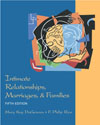 |  Intimate Relationships, Marriages, and Families, 5/e Mary K. DeGenova
Philip F. Rice
Table of ContentsIntimate Relationships, Marriages, and Families, Fifth Edition
Mary Kay DeGenova and F. Philip RicePreface
PART I. SOCIAL AND PSYCHOLOGICAL
PERSPECTIVES: COGNITION AND
CHALLENGE
1.Intimate Relationships, Marriages, and
Families in the Twenty-First Century
What Is a Family?
Changes in Family Philosophy and Emphasis
Changes in Marriage and Parenthood
Changes in Divorce and Remarriage
Changes in Nonmarital Sexual Behavior
Family Theories to Help Explain Behavior
2.Family Backgrounds and How They
Influence Us
Why Examine Family Background?
Parental Attitudes Toward Children
Attitudes Toward Intimate Partners
Family Closeness: Attitudes Toward Intimacy
Attitudes Toward Sex
Attitudes Toward Marriage and Divorce
Gender-Role Socialization in the Family
Variations in Family Values and Work Habits
Communicative, Noncommunicative, and
Conflictive Families
3.Cultural and Ethnic Differences in Families
African American Families
Mexican American Families
Native American Families
Chinese American Families
Conclusions
PART II. INTIMATE RELATIONSHIPS:
CHOICES AND CHANGE4.Being Single
Categories of Singles
Marital Delay
Why Some People Remain Single
Advantages and Disadvantages of Being Single
The Health and Well-Being of Singles
Living Arrangements
Loneliness and Friendships
Sexual Behavior
Employment and Income
Single Mothers
The Older Never-Married Adult
5.Dating, Going Together, and Courtship
The Dating System
Reasons for Dating
Dating Partners Versus Long-Term Partners
Finding and Meeting Dates
Changing Gender Roles in Dating
Problems in Dating
Sexual Aggression and Dating Violence
Breaking Up A Relationship
6.Attraction and Love
Attraction
What Is Love?
Romantic Love
Erotic Love
Dependent Love
Friendship Love
Altruistic Love
Components of Love
Changes Over Time
7.Gender: Identity and Roles
Environmental Influences on Gender
Theories of Gender Role and Identity
Traditional Masculine and Feminine
Stereotypes
Gender Roles and Body Image
Gender Roles in the Family
Androgyny
8.The Sexual Basis of Relationships
Sex and a Happy Marriage
Phases of Human Sexual Response
Sources of Sexual Arousal
Lovemaking Principles
Sexual Dysfunction
Sexually Transmitted Diseases
9.Mate Selection, Nonmarital Cohabitation,
and Transition to Marriage
Theories of Mate Selection
Family Background Factors in Mate Selection
Personal Characteristics
Why Some People Regret Their Choice of
Mate
Nonmarital Cohabitation
The Transition to Marriage
Rites of Passage
PART III. MARRIAGES AND FAMILY RELA-TIONSHIPS:
CHALLENGES AND
COMMITMENT10.Qualities of Successful Marriages
Criteria for Evaluating Marital Success
Happy Versus Unhappy Marriages
Twelve Characteristics of Successful Marriages
11.Marital Relationships Over The Family Life
Cycle
Marriage and Personal Happiness
The Family Life Cycle
Adjustments Early in Marriage
Adjustments to Parenthood
Adjustments During Middle Adulthood
Adjustments During Late Adulthood
Widowhood
12.Work, Family Roles, and Material
Resources
Work and the Family
Employed Women and the Family
Dual-Career Families
Material Resources
Poverty and Family Life
13. Companionship in and Outside the Family
Companionship and the Family
Companionship in Leisure Time Activities
Beyond the Family
14.Power, Decision Making, and
Communication
The Meaning of Power
Why People Want Power
Sources of Power
Marital Power Patterns
Power Processes
Consequences of Power Struggles
Communication
Improving Communication Skills
PART IV. COGNITION AND CHANGE
15.Family Planning and Parenthood
The Importance of Family Planning
Hormonal Control
Vaginal Spermicides
Intrauterine Devices
Barrier Methods
Sterilization
Birth Control Without Devices
Choosing a Method of Contraception
Abortion
Infertility
To Parent or Not To Parent
16.Pregnancy and Childbirth
Pregnancy
Prenatal Care
Prenatal Development
Prepared Childbirth
Labor and Delivery
The Postpartum Period
17.Parent-Child Relationships
Philosophies of Child Rearing
Parental Roles
Fostering cognitive and Intellectual Growth
Meeting Emotional Needs
Socialization and Discipline
One-Parent Families
18.Parents and Extended Family Relationships
Parent-Adult Child Relationships
In-Laws
Living With Parents or In-Laws
Grandparents
PART V. FAMILY STRESS AND REORGANIZA-TION:
CHOICES AND COMMITMENT
19.Conflict, Family Crises, and Crisis
Management
Conflict and Children
Sources of Conflict
Methods of Dealing with Conflict
Family Crises
The Crisis of Infidelity
The Crisis of Economic Distress
The Crisis of Violence and Abuse
The Crisis of Death and Grief
20.The Troubled Family and Divorce
Probability of Divorce: Social and
Demographic Factors
Causes of Marital Breakup
The Divorce Decision
Alternatives to Divorce
No-Fault Divorce and Mediation
Adult Adjustments After Divorce
Children and Divorce
21.Coming Together: Remarriage and
Stepparenting
Remarriage
Stepfamilies
Stepparent-Stepchild Relationships
Stepsibling Relationships
Glossary
Bibliography
Credits
Author Index
Subject Index
Each chapter contains: Key Terms, Summary,
Questions for Thought, Suggested Readings |
|



 2002 McGraw-Hill Higher Education
2002 McGraw-Hill Higher Education